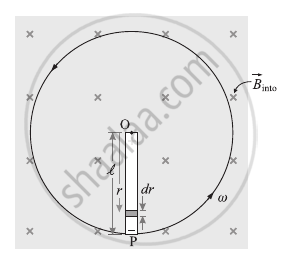Advertisements
Advertisements
प्रश्न
Determine the motional emf induced in a straight conductor rotating in a uniform magnetic field with constant angular velocity about a transverse axis through one end.
उत्तर
Consider the following scenario as seen in the picture, a rod of length l is rotated counterclockwise around an axis that passes through one end and is perpendicular to its length, in a plane perpendicular to a uniform magnetic field of induction `vecB`. `vecB` points into the page. Assume that the rod's constant angular speed is ω.

A rod rotating in a uniform magnetic field
Consider an infinitesimal length element dr at a distance r from the rotation axis. In one rotation, the area traced by the element is dA = 2πrdr. Therefore, the time rate at which the element traces out the area is
`(dA)/dt` = frequency of rotation × dA = fdA
where f = `ω/(2π)` is the frequency of rotation.
∴ `(dA)/dt = ω/(2π) (2πrdr) = ωrdr`
Therefore, the magnitude of the induced emf in the element is
`|de| = (dΦ_m)/dt`
= `B(dA)/dt`
= Bωrdr
Since the emfs in all the elements of the rod will be in series, the total emf induced across the ends of the rotating rod is
`|e| = int de`
= `int_0^l Bωrdr`
= `Bω int_0^l rdr`
= `Bω (int^2)/2`
For anticlockwise rotation in `vec (B)` pointing into the page, the pivot point O is at a higher potential.
